The University of Georgia (UGA) is the oldest, largest, and most comprehensive educational institution in Georgia. Chartered by the Georgia General Assembly in 1785, UGA was the first university in America to be created by a state government, and the principles undergirding its charter helped lay the foundation for the American system of public higher education. UGA strives for excellence in three fundamental missions: providing students with outstanding instruction in classrooms and laboratories, providing Georgia citizens with information and assistance to improve quality of life in the state, and discovering new knowledge and information through advanced research.
Reflecting its rising academic stature, UGA placed twentieth on U.S. News and World Report’s 2015 list of the nation’s top fifty public universities. In 2003 UGA joined Harvard, Yale, and Brown universities as the only schools with recipients of Rhodes, Marshall, Truman, and Goldwater scholarships—four of the most prestigious scholarships awarded to American undergraduates. With four Rhodes scholars between 1996 and 2003, UGA had more Rhodes recipients than any state university in America during that time period.
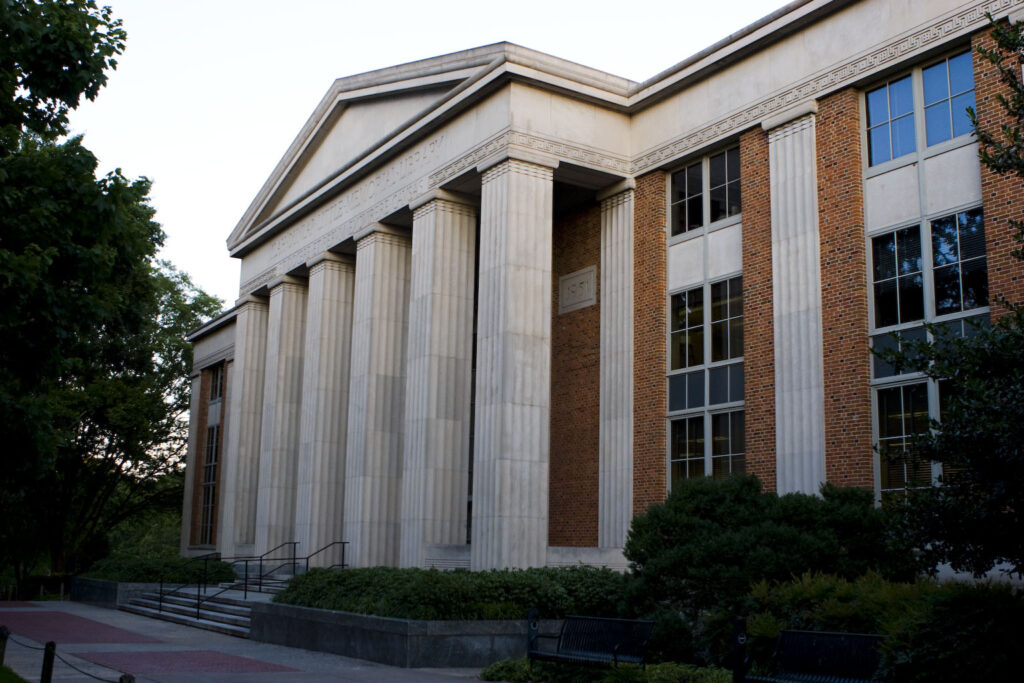
Photograph from Zlatko Unger
Situated on a 706-acre main campus, UGA has a workforce of more than 9,800, an annual budget of about $1.4 billion, and a physical plant valued at some $500 million, making it one of the largest employers in Georgia and a major contributor to the state’s economic and cultural vitality. Through its Graduate School and sixteen other schools and colleges, the university offers the widest array of academic opportunities in the state.
A rising academic reputation, the tuition-free HOPE and Zell Miller scholarships, and relatively low costs make UGA one of the nation’s most affordable and attractive public universities. Enrollment continues to rise, totalling 35,197 undergraduate and graduate students in the fall of 2014. UGA ranked fifth among public universities on U.S. News and World Report’s 2003 list of “Great Schools at Great Prices” and tenth on Kiplinger magazine’s 2015 list of the best value public colleges.
UGA is located in Athens–Clarke County, about seventy miles northeast of Atlanta. Incorporated in 1806, Athens is the educational, commercial, and cultural hub of northeast Georgia, combining southern charm with an economy fueled by service industries, medical facilities, government offices, a thriving arts and crafts community, and a lively entertainment scene. (Athens was number eight on Rolling Stone magazine’s list of “campus scenes that rock” in 2005.)

Photograph by Melinda G. Smith, New Georgia Encyclopedia
UGA is the city’s dominant economic engine, contributing some $2.1 billion in 2012 to the Athens economy through salaries, student spending, and income from thousands of visitors who attend athletic contests and other campus events. UGA-related spending accounts for more than one out of five jobs held by area residents. The university’s scientific initiatives pump millions into the economy through the construction of new facilities, recruitment of highly paid researchers, and creation of new businesses. UGA research has spawned some fifty new businesses in the Athens area, including twelve firms with more than ninety employees, who started in two university-affiliated business “incubators”—the Georgia BioBusiness Center and the Athens New Media Synergy Center.
One of UGA’s most important contributions has been fostering a culture of leadership for the state. In virtually every realm, UGA alumni have left their mark on Georgia. Augustin Smith Clayton, a member of the first graduating class in 1804, served in the U.S. Congress, and over the ensuing 200 years at least twelve graduates have served in the U.S. Senate and more than three dozen were congressmen. Between 1851 and 2011 twenty-five Georgia governors have been UGA alumni. Many graduates have served on the Georgia Supreme Court and held federal cabinet posts. Among other notable alumni are Crawford W. Long, who discovered how to use ether as an anesthetic; Henry W. Grady, a post–Civil War journalist and the voice of the New South; Charles Herty, whose chemical expertise helped create the pulp-and-paper industry in the South; Eugene Black, the first U.S. executive director of the World Bank; the southern humorist Lewis Grizzard; Zell Miller, a governor, a U.S. senator, and the father of the HOPE Scholarship; and Robert Benham, the first African American on the Georgia Supreme Court and the first to serve as chief justice.
History
Eighteenth Century
In February 1784, just after the close of the Revolutionary War, the General Assembly of Georgia earmarked 40,000 acres of land to endow “a college or seminary of learning.” The following year, Abraham Baldwin, a lawyer and minister educated at Yale University in New Haven, Connecticut, who had settled in Georgia in 1783, wrote the charter that created the University of Georgia. Reflecting the exuberance of newfound freedom sweeping through the colonies, Baldwin created a populist document that departed sharply from conventional notions about higher education. The charter asserted that an educated citizenry is essential to a free government, that government has a responsibility to see that its citizens receive an education, and that all people—not just the wealthy and privileged—have a right to education. The legislature’s approval of the charter on January 27, 1785, made UGA the first university established by a state government and provided the framework for what would become the American system of publicly supported colleges and universities.
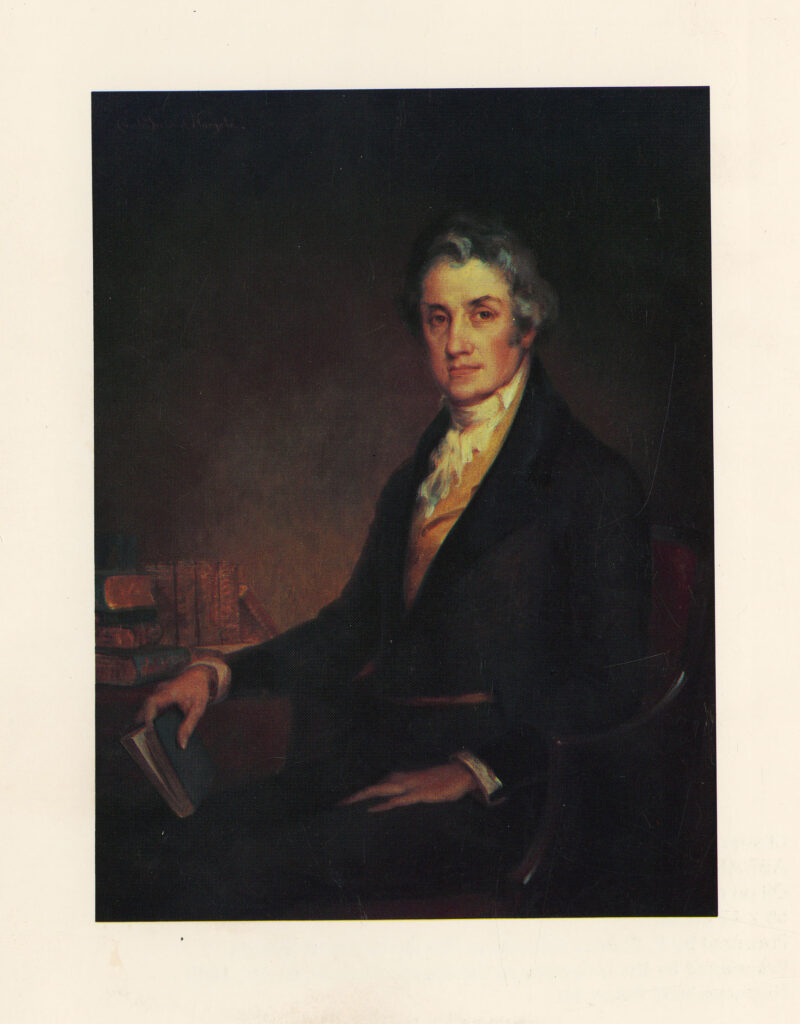
Courtesy of University of Georgia Photographic Services
Nineteenth Century
For the next sixteen years the university existed only on paper, as Georgia’s leaders, occupied with the more pressing business of creating a state, used the land designated for a college for other purposes. In 1801 interest in the university revived, and John Milledge, a lawyer and legislator, bought 633 acres along the frontier on the Oconee River and donated the land as a site for the school. Josiah Meigs, another Yale graduate, was appointed president and sole faculty member and in September 1801 taught the first university classes. The first permanent university building, a three-story brick structure, was completed in 1806 and named Franklin College in honor of Benjamin Franklin. It was the only university building until 1821, and for many years the university was commonly known as Franklin College, though its official name was the University of Georgia. As the school grew, a division for classes in the liberal arts and basic sciences emerged; the division was named the Franklin College of Arts and Sciences.
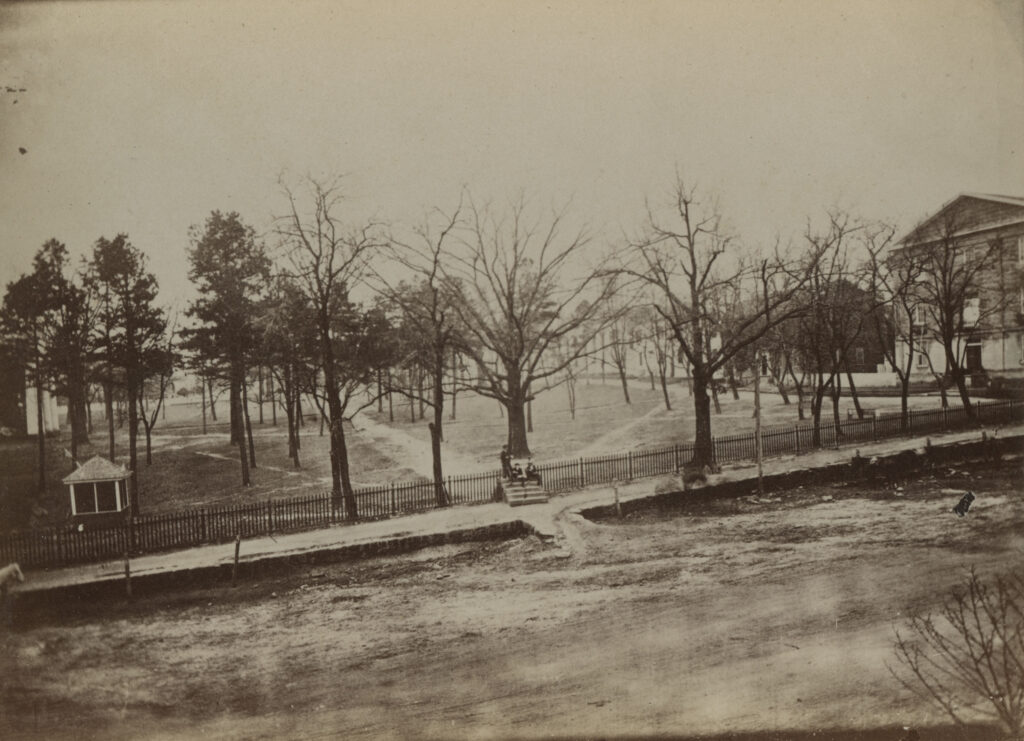
Courtesy of Hargrett Rare Book and Manuscript Library, University of Georgia Libraries.
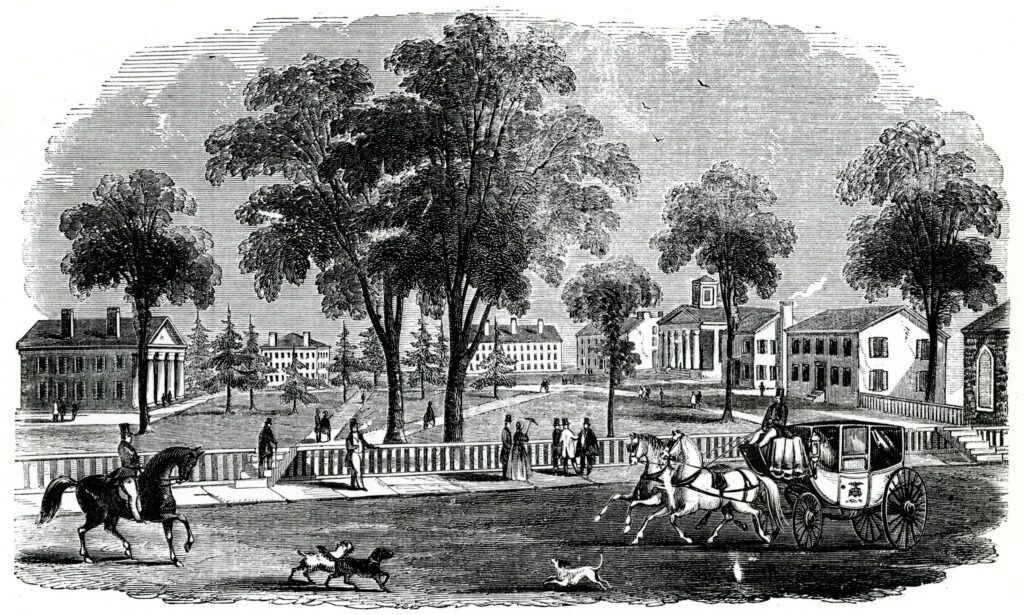
Courtesy of Hargrett Rare Book and Manuscript Library, University of Georgia Libraries.
The young school struggled financially in its early years, and only the College of Arts and Sciences existed until 1859, when the School of Law was started. Closed for two years during the Civil War (1861-65), the university escaped possible bankruptcy in 1872 when it was designated a federal land-grant institution under the Morrill Act, which also tasked the university with teaching agriculture and the mechanical arts. This legislation, and later companion laws, formalized the university’s public service mission. Fort Valley State University and the University of Georgia are the only federal land grant universities in the state.
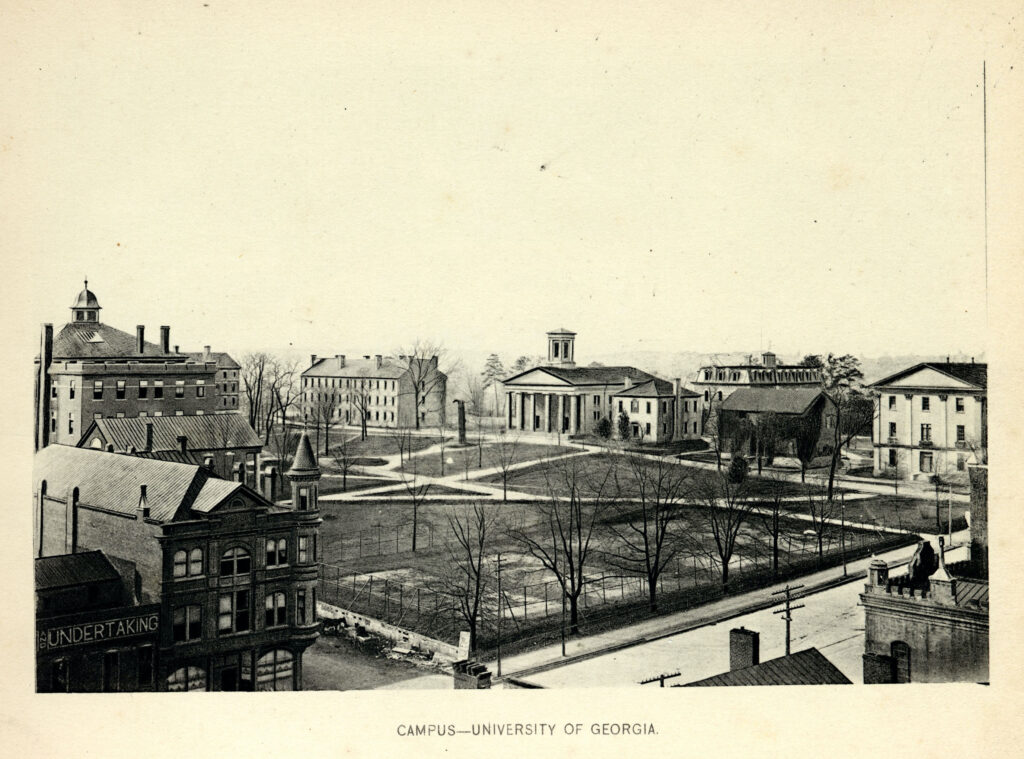
Courtesy of Hargrett Rare Book and Manuscript Library, University of Georgia Libraries.
Twentieth Century
Schools of pharmacy, forestry, education, business, journalism, and home economics and a graduate school were started in the early twentieth century, and in 1918 women were admitted as regular students. The creation of the University System of Georgia in 1932 brought the university and the state’s twenty-five other public colleges together under the centralized administrative control of the Board of Regents and spun off several university branch campuses as separate institutions. The State College of Agriculture and the State Teachers College were merged with the university.
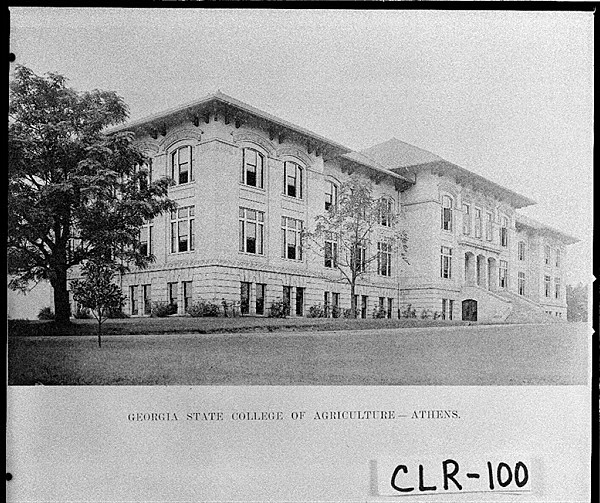
Courtesy of Georgia Archives.
In January 1961 UGA was racially integrated when two college students from Atlanta, Hamilton Holmes and Charlayne Hunter, transferred and became the first African Americans to enroll. Later that year Mary Frances Early, an African American who was in graduate school at the University of Michigan, transferred to UGA and in 1962 received a master’s degree in music education, becoming the first African American to graduate. Holmes and Hunter (later Hunter-Gault) graduated in 1963.
UGA significantly escalated its support for research and technological innovation in the second half of the twentieth century. The veterinary medicine college was started, and a six-building science center was completed in 1960. Under UGA president Fred Davison, research income and expenditures tripled between the late 1960s and mid-1980s, as the university recruited nationally known scientists to build expertise in such areas as biotechnology, genetics, ecology, and computer development.
While strengthening research, UGA also greatly expanded its public service program, anchored for years in the Cooperative Extension Service and its agents throughout the state. The Georgia Center for Continuing Education was established in 1953, and the Marine Extension Service was created to assist the fishing and seafood industries. Specialized institutes were formed to train government and community development officials around the state, and to provide ongoing education for judges, court officials, and lawyers. The schools of social work and environmental design opened in the late 1960s.
In 1985 UGA became the first public institution of higher education in America to celebrate its bicentennial, at the same time completing its first major fund-raising drive. Nearly $400 million worth of construction was completed or started between 1987 and 1997, during the administration of UGA president Charles Knapp. East campus was opened, featuring a $37 million arts-and-music complex, a $40 million student physical activities and fitness center, and a $10 million student health center.
In the summer of 1996 UGA hosted soccer, volleyball, and rhythmic gymnastics competitions during the Olympic Games. In 1998 history and law professor Edward Larson became the first faculty member to win a Pulitzer Prize. The university’s fourteenth school—the School of Public and International Affairs—was established in 2001, and the College of Environment and Design was created by merging the Institute of Ecology (later the Eugene P. Odum School of Ecology) and School of Environmental Design.

Courtesy of University of Georgia Photographic Services
Twenty-first Century
Michael F. Adams was the president of the university between 1997 and 2013. He was succeeded upon his retirement by Jere W. Morehead, who had served as the university’s senior vice president for academic affairs and provost since 2010.
UGA’s programs in business, education, journalism, and public administration are highly regarded. The university’s library, with more than 3.9 million volumes, is the largest academic library in Georgia and ranks among the nation’s best research libraries, according to the Association of Research Libraries.
The faculty of 2,800 includes internationally known scholars, scientists, writers, musicians, and artists. Nine current or former UGA faculty members have been elected to the National Academy of Sciences, and two are members of the National Academy of Engineering. Eight current or former professors have been elected to the American Academy of Arts and Sciences. Twelve faculty members—with expertise ranging from X-ray crystallography to development of vaccines for combating viral infections—have been designated Eminent Scholars under the Georgia Research Alliance. In 2003 history professor Eve Troutt Powell received a MacArthur Foundation Fellowship, the first faculty member to be so honored.
UGA is home to the Georgia Writers Hall of Fame and three official state entities: the State Botanical Garden, a 313-acre preserve with specialty gardens, trails, and a conservatory; the Georgia Museum of Art, with a permanent collection of more than 9,000 works; and the Georgia Museum of Natural History, the largest collection of Georgia natural history artifacts and specimens, with more than 4.5 million items. In addition to its land grant status, UGA has been designated a sea grant college in recognition of excellence in marine research, education, and advisory services. In 2013 the university merged with the Skidaway Institute of Oceanography, a research unit of the University System of Georgia located near Savannah.
The Grady College of Journalism and Mass Communication administers the prestigious Peabody Awards, which recognize outstanding American television and radio news, entertainment, and children’s programming. UGA and Delta Air Lines annually present the Delta Prize for Global Understanding to honor individuals or groups for promoting peace and cooperation among cultures and nations. The Georgia Review, UGA’s quarterly literary journal, consistently competes with leading popular magazines for the National Magazine Award, and the University of Georgia Press is considered one of the best scholarly publishing houses in the country.
UGA Students
As Georgia’s flagship institution, UGA’s first obligation is to educate the state’s young people, and about 82 percent of university students are Georgia residents. With its rising academic stature and moderate costs, UGA is an increasingly popular choice for high school graduates. During the 2000s freshman applications averaged 12,400 for a class of about 4,000; by 2013 applications numbered almost 20,000 for a class of 5,000.
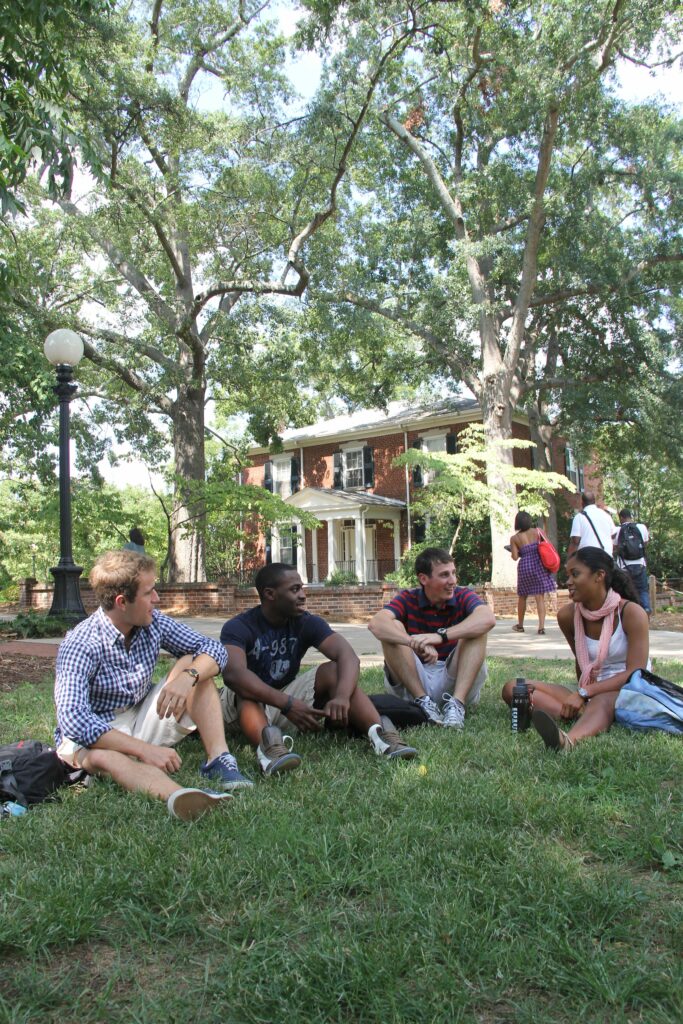
Photograph by Stephanie Schupska
International enrollment is also rising; in 2014 UGA was home to more than 2,600 students from 125 different countries, up from 2,058 international students in 2003. More than 1,200 undergraduates annually participate in about eighty study-abroad programs in countries around the world, ranking UGA tenth among the twenty research universities with the most students studying abroad. UGA athletic teams won forty national championships between 1980 and 2015, and the athletic program is regularly judged among the best in the country.
With the opening of the $43 million Miller Learning Center in fall 2003, UGA students have one of the largest and most technologically advanced study environments in the country. The 200,000-square-foot center includes computer-wired classrooms; an electronic library that seats 2,240, provides 500 computer workstations, and has more than 1,000 connections for laptop computers; and numerous study and meeting rooms. In 2012 the Richard B. Russell Building, housing the Special Collections Libraries, opened its doors. The building features a state-of-the-art subterranean vault for storing archival collections as well as reading rooms and exhibition space for the Hargrett Rare Book and Manuscript Library, Richard B. Russell Library for Political Research and Studies, and Walter J. Brown Media Archives and Peabody Awards Collection.
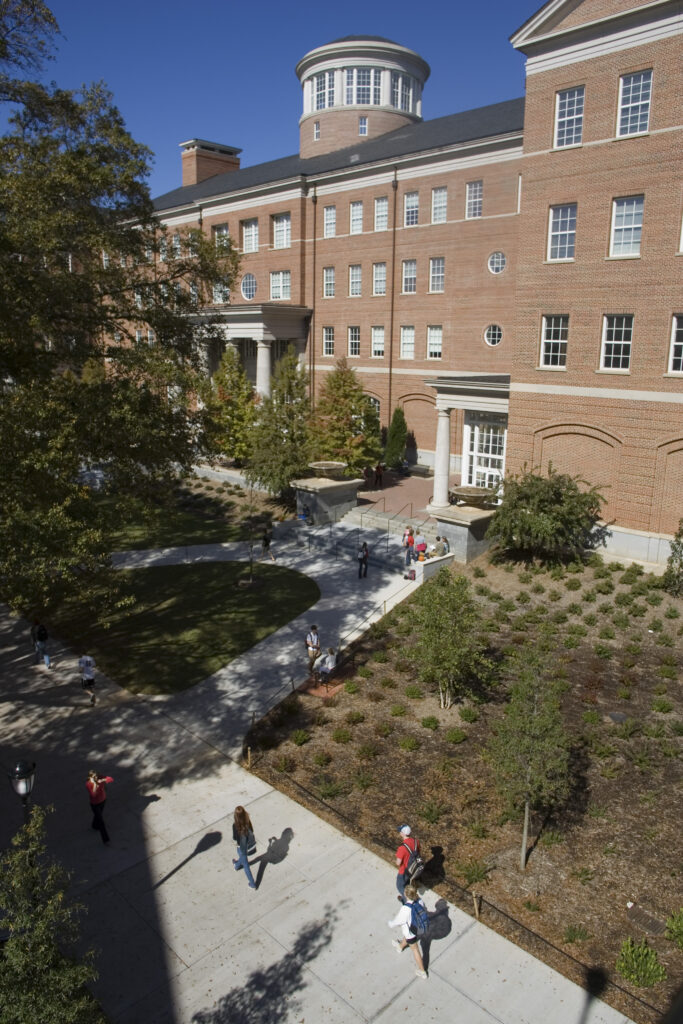
Photograph by John Amis
Public Service
As a federal land-grant university, UGA has a mandate to make available its personnel and resources to improve life in Georgia. The public service and outreach program includes nine service units, Cooperative Extension Service faculty and staff in most of the state’s 159 counties, and formalized outreach activities in most of the university’s seventeen schools and colleges. The university annually spends more than $138 million on public service and outreach, and in 2003 service staff logged more than 1.5 million contact hours through continuing professional education activities and other programs around the state.
From its historic beginnings as a provider of practical advice to farmers and homemakers, the public service program has expanded and diversified to keep pace with economic, social, and cultural changes in the state. UGA staff members demonstrate their expertise in thousands of service fields, ranging from improving nutritional practices for low-income people, to strengthening K-12 education, to helping local governments and businesses implement new technology. The Georgia Center for Continuing Education is one of the state’s largest providers of continuing professional programs, not only through hundreds of on-campus conferences and workshops but also through distance education courses, teleconferences, Web-based learning opportunities, and WUGA, the university’s Georgia Public Broadcasting affiliate.
In keeping with UGA’s growing international presence, the public service program has expanded to other countries, with faculty providing assistance in Europe, Africa, Asia, and South America. The Office of International Public Service and Outreach provides grants that enable faculty to conduct technology, education, agriculture, food processing, and environmental conservation programs in other countries. The International Center for Democratic Governance, an arm of the Carl Vinson Institute of Government, helps emerging democracies build efficient governmental and administrative systems.
Research
With a research budget that exceeds $250 million and more than 50 specialized research centers, UGA research spans virtually every academic field. Areas of particular strength include genetics, molecular biosciences, biomedicine, chemistry, food production, information technology, business, education, and ecology and the environment. In fiscal year 2013, UGA faculty received $133.2 million in research awards, and research expenditures in fiscal year 2012 totaled $157.1 million. UGA was ranked sixty-fourth in research and development expenditures by the National Science Foundation in 2013 and is in the tenth percentile of all major research universities in research and development expenditures.
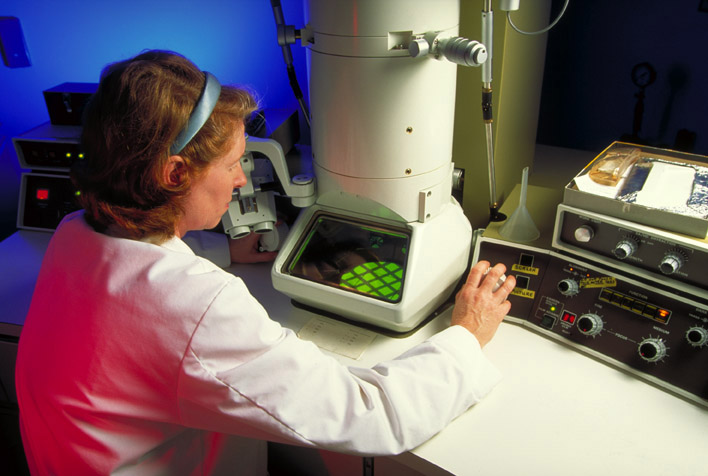
Courtesy of UGA Photographic Services
UGA has coalesced its multidisciplinary expertise to concentrate research in the fields of health science and engineering. The Biomedical and Health Sciences Institute, established in 2001, brings together dozens of scientists from many departments to focus on areas of molecular medicine, infectious disease and immunity, neuroscience, and public health. The institute is housed in a new $40 million building named for the late U.S. senator Paul Coverdell. The Paul D. Coverdell Center for Biomedical and Health Sciences, completed in 2005, is also home to the Center for Tropical and Emerging Global Diseases, a cross-disciplinary unit that focuses on diseases that have emerged from isolated areas to afflict people around the world. Another major new research facility—a $34 million home for the Complex Carbohydrate Research Center—provides space for 260 scientists and support staff who study the role of complex carbohydrates in cancer, arthritis, and other human diseases.
In 2005 the university received a three-year grant for $3.5 million from the Centers for Disease Control and Prevention to create the Southern Center for Communication, Health, and Poverty. The center, an interdisciplinary project of the Department of Speech Communication, the Grady College of Journalism and Mass Communication, the Terry College of Business, the Institute for Behavioral Research, and the Department of Sociology, seeks to improve health communication to the poor in the Southeast.
As part of an initiative to help meet the state’s growing need for physicians, UGA formed a partnership with Georgia Health Sciences University, based in Augusta, to establish a new campus in Athens. This collaboration came to be known as the Georgia Health Sciences/University of Georgia Medical Partnership, and in January 2012 the UGA Health Sciences Campus opened on the grounds of the former Navy Supply Corps School.
More than seventy faculty members in twenty-five departments who have expertise in specialized areas of engineering formed the College of Engineering in 2012. In addition to awarding degrees in specialized areas of engineering, the college coordinates research and works with citizens and industries to promote economic development and technologies in the state.
UGA has also emerged as a leader in the science of genetic engineering with the work of researchers who have successfully cloned pigs and calves, for instance. The Center for Applied Genetic Technologies, created in conjunction with the Georgia Research Alliance, represents a $28 million investment in such technology as transgenics, genomics, bioinformatics, and other genetic engineering technology.




























